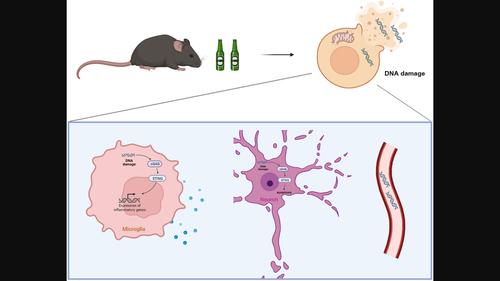当前位置:
X-MOL 学术
›
CNS Neurosci. Ther.
›
论文详情
Our official English website, www.x-mol.net, welcomes your feedback! (Note: you will need to create a separate account there.)
Activation of STING signaling aggravates chronic alcohol exposure‐induced cognitive impairment by increasing neuroinflammation and mitochondrial apoptosis
CNS Neuroscience & Therapeutics ( IF 5.5 ) Pub Date : 2024-03-22 , DOI: 10.1111/cns.14689 Xinrou Lin 1, 2 , Xiangpen Li 1, 3 , Chenguang Li 1 , Hongxuan Wang 1 , Lubin Zou 1, 2 , Jingrui Pan 1, 3 , Xiaoni Zhang 1 , Lei He 1 , Xiaoming Rong 1 , Ying Peng 1, 2, 4
CNS Neuroscience & Therapeutics ( IF 5.5 ) Pub Date : 2024-03-22 , DOI: 10.1111/cns.14689 Xinrou Lin 1, 2 , Xiangpen Li 1, 3 , Chenguang Li 1 , Hongxuan Wang 1 , Lubin Zou 1, 2 , Jingrui Pan 1, 3 , Xiaoni Zhang 1 , Lei He 1 , Xiaoming Rong 1 , Ying Peng 1, 2, 4
Affiliation

|
AimsChronic alcohol exposure leads to persistent neurological disorders, which are mainly attributed to neuroinflammation and apoptosis. Stimulator of IFN genes (STING) is essential in the cytosolic DNA sensing pathway and is involved in inflammation and cellular death processes. This study was to examine the expression pattern and biological functions of STING signaling in alcohol use disorder (AUD).MethodsCell‐free DNA was extracted from human and mouse plasma. C57BL/6J mice were given alcohol by gavage for 28 days, and behavior tests were used to determine their mood and cognition. Cultured cells were treated with ethanol for 24 hours. The STING agonist DMXAA, STING inhibitor C‐176, and STING‐siRNA were used to intervene the STING. qPCR, western blot, and immunofluorescence staining were used to assess STING signaling, inflammation, and apoptosis.ResultsCirculating cell‐free mitochondrial DNA (mtDNA) was increased in individuals with AUD and mice chronically exposed to alcohol. Upregulation of STING signaling under alcohol exposure led to inflammatory responses in BV2 cells and mitochondrial apoptosis in PC12 cells. DMXAA exacerbated alcohol‐induced cognitive impairment and increased the activation of microglia, neuroinflammation, and apoptosis in the medial prefrontal cortex (mPFC), while C‐176 exerted neuroprotection.ConclusionActivation of STING signaling played an essential role in alcohol‐induced inflammation and mitochondrial apoptosis in the mPFC. This study identifies STING as a promising therapeutic target for AUD.
中文翻译:

STING 信号的激活会增加神经炎症和线粒体凋亡,从而加重慢性酒精暴露引起的认知障碍
目的慢性酒精暴露会导致持续的神经系统疾病,这主要归因于神经炎症和细胞凋亡。 IFN 基因刺激剂 (STING) 在细胞质 DNA 传感途径中至关重要,并参与炎症和细胞死亡过程。本研究旨在检测酒精使用障碍(AUD)中STING信号的表达模式和生物学功能。方法从人和小鼠血浆中提取游离DNA。 C57BL/6J 小鼠灌胃饮酒 28 天,并通过行为测试来确定其情绪和认知。将培养的细胞用乙醇处理24小时。使用STING激动剂DMXAA、STING抑制剂C-176和STING-siRNA来干预STING。 qPCR、蛋白质印迹和免疫荧光染色用于评估 STING 信号传导、炎症和细胞凋亡。结果 AUD 患者和长期接触酒精的小鼠中循环游离线粒体 DNA (mtDNA) 增加。酒精暴露下 STING 信号上调导致 BV2 细胞炎症反应和 PC12 细胞线粒体凋亡。 DMXAA 加剧了酒精引起的认知障碍,并增加了内侧前额叶皮层 (mPFC) 中小胶质细胞的激活、神经炎症和细胞凋亡,而 C-176 则发挥了神经保护作用。 结论 STING 信号传导的激活在酒精引起的炎症和线粒体凋亡中发挥了重要作用在 mPFC 中。这项研究将 STING 确定为 AUD 的一个有前途的治疗靶点。
更新日期:2024-03-22
中文翻译:

STING 信号的激活会增加神经炎症和线粒体凋亡,从而加重慢性酒精暴露引起的认知障碍
目的慢性酒精暴露会导致持续的神经系统疾病,这主要归因于神经炎症和细胞凋亡。 IFN 基因刺激剂 (STING) 在细胞质 DNA 传感途径中至关重要,并参与炎症和细胞死亡过程。本研究旨在检测酒精使用障碍(AUD)中STING信号的表达模式和生物学功能。方法从人和小鼠血浆中提取游离DNA。 C57BL/6J 小鼠灌胃饮酒 28 天,并通过行为测试来确定其情绪和认知。将培养的细胞用乙醇处理24小时。使用STING激动剂DMXAA、STING抑制剂C-176和STING-siRNA来干预STING。 qPCR、蛋白质印迹和免疫荧光染色用于评估 STING 信号传导、炎症和细胞凋亡。结果 AUD 患者和长期接触酒精的小鼠中循环游离线粒体 DNA (mtDNA) 增加。酒精暴露下 STING 信号上调导致 BV2 细胞炎症反应和 PC12 细胞线粒体凋亡。 DMXAA 加剧了酒精引起的认知障碍,并增加了内侧前额叶皮层 (mPFC) 中小胶质细胞的激活、神经炎症和细胞凋亡,而 C-176 则发挥了神经保护作用。 结论 STING 信号传导的激活在酒精引起的炎症和线粒体凋亡中发挥了重要作用在 mPFC 中。这项研究将 STING 确定为 AUD 的一个有前途的治疗靶点。



























 京公网安备 11010802027423号
京公网安备 11010802027423号